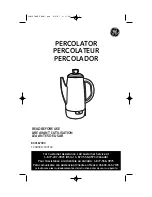
pg 4
CLEANING AND MAINTENANCE
Do not wash in a dishwasher and never put ii in a heated dish dryer. (The
unit may become deformed.) Store the unit in a cool, dry place. To remove
any discoloration from the area above the full pot mark, rub the inside
lightly with a wet sponge. If the discoloration can not be removed by
rubbing, clean the pot several times by using citric acid, (see the following
page).
1. To clean the main unit and lid, wipe any water off by using a
dry dish cloth.
2. Do not wash the main unit and the lid with water. (If water
enters the main unit from the bottom or from the dispensing
spout, it also gets into the electrical components in the main
unit and it may cause a malfunction.)
3. Do not use detergents. (They may leave an odor.)
4. Do not use benzine or thinner to clean the pot. (They may
damage the surface.)
5. Wipe any water off the inside of the inner pot by using a damp
sponge.
6. Do not use polishing powder, a scrub brush or a nylon brush to clean
the inner pot.
7. Clean the filter by using a brush. After washing the filter, be sure to
reattach it to the inner pot.
8. While you are using this unit, minerals dissolved in the water (like
calcium) can get stuck on the inner pot or on the filter. This is called
scale, and it is not harmful. It may appear in the following ways:
Milky-white gritty surface, white or glittering floating material,
discoloration in the finish like dark brown, gray, or green areas. These
are not discoloration or corrosion of the inner pot Itself, nor are they
flakes from the coating.
9. When using tap water it is important to clean the bottom heating
element and the sides of the unit once every two weeks.
10. To remove calcium deposits, boil water with vinegar or lemon juice.
NOTE: any damage to the unit caused by calcium deposits is not
covered under the warranty.

























